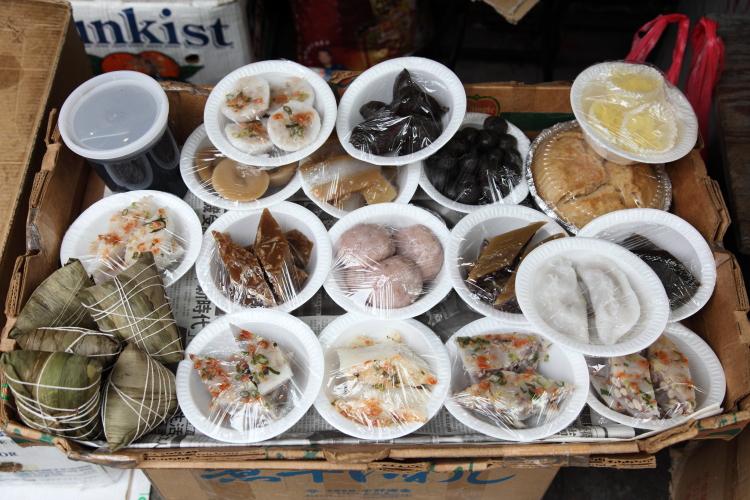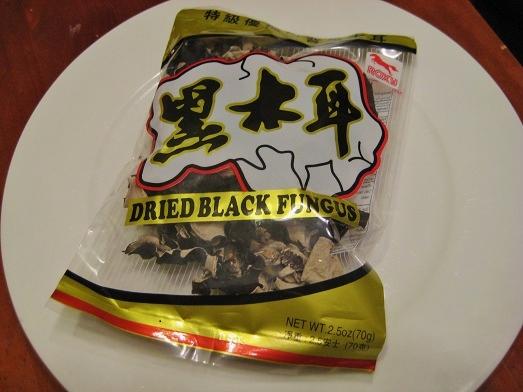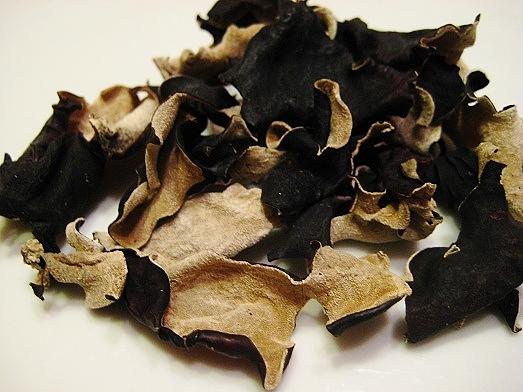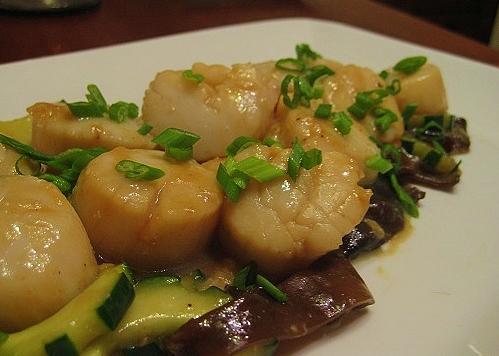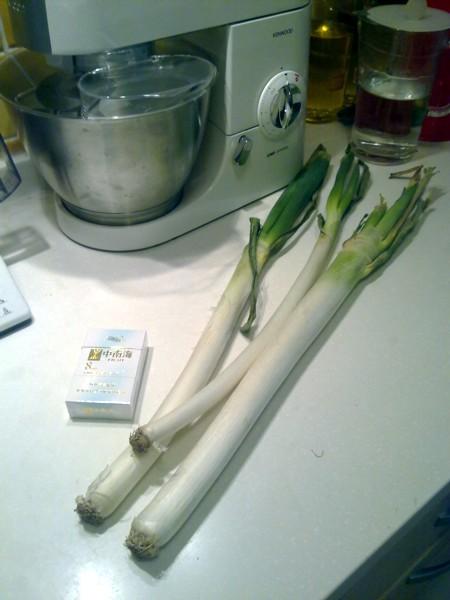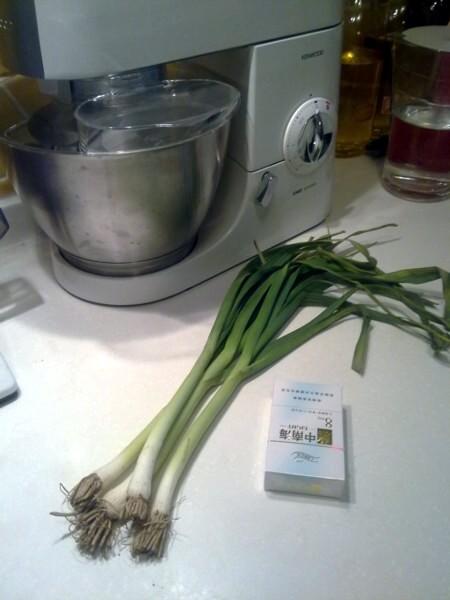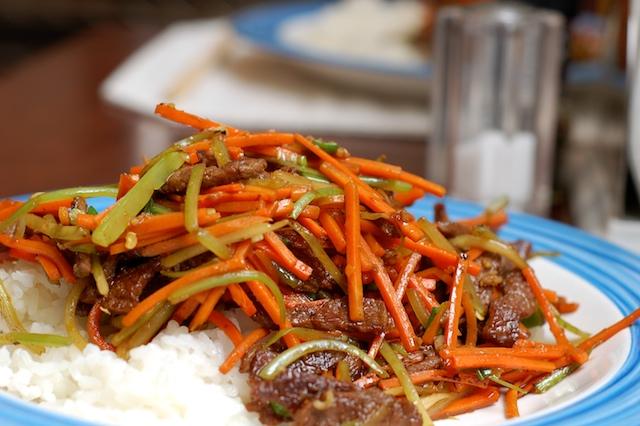Search the Community
Showing results for tags 'Chinese'.
-
My friend's dad used to make this chunky chili sauce that I just love. In terms of texture, it's really chunky, even more so than XO sauce. He is Chinese but have connection with Southeast Asia, so I'm not really sure where this may originate from. Things I know is in there: -fresh chili -garlic -dried shrimp -Chinese sausage -oil Things that may be in there: -dried mushroom -salted radish -shallot -sugar -salt -fish sauce Does anyone have any idea what kind of chili sauce this is? Recipe?
-
Got some duck legs in the freezer along with some homemade buns (Momofuku recipe). I'm wondering if I turn the legs into something similar to Cantonese roast duck or even Peking duck. Anyone tried it before? Would I need to brine them? What kind of marinade? What temp and how long to roast for in the oven? Suggestions/guidance much appreciated.
-
I'm trying to track down more information on this food. I came across it on a blog post, but I forgot to bookmark it. The recipe is simple, just drizzle a little water into a pile of flour, and stir it around until you get little lumps. Just like making struesal (crumb topping for coffee cake). You then cook them directly in the soup. The original blog post had them cooked in tomato soup. The tomatoes were diced. Does anyone know the name of the dish and where it comes from? My memory of the pinyin must be really bad, because I can't find it on google. Searching in English just leads me to jiaozi type stuff.
-
I love Ma Po tofu. Love it. I make it all the time and have tried various recipes and they just are not up to snuff. I have had good versions in restaurants and can't replicate them for the life of me. I tend to come out too dry or if the sauce is the right amount and consistency, the flavor is not right. Can someone give me an authentic recipe that ends up with the right proportion of ingredients and flavor? Thanks in advance.
-
Got a take out menu from a local Chinese restaurant so I browsed through it. I came across "Short or Long Soup." I had no idea what the heck that was. I googled it and found that short soup means wonton/dumpling soup and long soup means noodle soup. If you want wonton noodle soup, it would be a short and long soup. I read somewhere that long is referred to the length of the noodle. But how did that get turn into long soup? Never heard of this in Hong Kong, in China or the US. Is this just an Australian thing? Just find this interesting and wonder if anyone know much about it.
-
My wife and I were watching a recent tv show (I think it was Bizarre Foods with Andrew Zimmern, but could have been No Reservations (Tony Bourdain)) where the person was in Hong Kong. In one scene, they showed someone making soy sauce noodles, which gave my wife a serious Proustian moment as she grew up in HK and misses it badly. Ever since then, she's been craving this dish. And, I have no idea what how to go about making this for her. From what I can tell, the dish seems to be just egg noodles, soy sauce, and bean sprouts. They're all stir fried on high heat. That's it. Clearly, there must be something more to this. Is it just soy sauce or some special blend of things? Garlic? Onion? I pretty much know that the "secret" is going to be in the frying part, but I'd at least like to have a small chance of recreating this by knowing what to put in the dish. So, I turn to the great masses of eGullet and ask: does anyone know what this dish is? And, can you please help me figure out how to recreate it?
-
I've used Wo Sun in a stir/fry, but I want to use this vegetable as a pickle. I've found a couple of recipes, but they seem pretty commonplace -- the usual sugar and vinegar. Anyone have a good one? I want to use it in a class where I introduce people to some of the vegetables they see in Chinese supermarkets, but don't know what they are, or how to use them.
-
One very traditional chinese way of cooking noodles & dumplings is to put the noodles/dumplings into boiling water, wait until it returns to a rolling boil and then adding a cup of cold water to the pot. This process is repeated 2 or 3 times and then noodles/dumplings are declared done. Does this have any effect on the final texture of the noodles or is purely a timing thing?
-
During my time in China, a dish became very popular in Beijing called 麻辣香锅 or "Ma La Xiang Guo", which I translate as "hot and numbing fragrant pot". It's basically a dry version of Sichuan hot pot, in which the diner generally picks out an array of meats, vegetables, fungi, etc that they want to have in their pot, along with the degree of spiciness they can tolerate, and then the kitchen puts it all together and serves it in a big wok on the table. The flavour is incredible, and if you put together an interesting combination of ingredients to go in the pot, it can be a fantastic dish. I would love to prepare it now that I'm no longer living in China; does anyone know how to make it? Searches on the internet have been rather unhelpful, I've found. Thanks!
-
I recently left China after living for four years in Beijing. I now live in New Zealand, where I have a small restaurant/lodge, and where I prepare all sorts of international cuisines for our guests (and ourselves). One thing I find I miss a lot, and that I'd love to make here, are some of the "small eats" (小吃) we'd enjoy in China, some from the street and some from restaurants. I wonder if anyone has a source for these, or if they could share some recipes they have for these sorts of dishes. In particular, I'd like to make the following: Hot and numbing peanuts (麻辣花生米) Old vinegar peanuts (老陈化生病米) Egg crepes (鸡蛋饼) Smashed marinated cucumber (拍黄瓜) Thanks!
-
Hey guys, just wondering...do any of you have any good recipes for Lao Po Bing???
-
Recently we've been talking about the used of Dried Ingredients in Chinese Cooking. Yet there is another category of ingredients that I've recently started exploring that are just as integral to Chinese cooking-fermented and preserved ingredients. (Some ingredients are simply dried, while others are fermented or preserved. Further, some ingredients may be dried and fermented or preserved). In America we seem to place our primary focus on ingredients that are fresh, fresh, fresh. And while the emphasis on freshness is certainly admirable, at the same time we seem to have forgotten the endless possibilities that fermented and preserved ingredients can lend to a wide variety of dishes. One of my favorite dried ingredients for Chinese style dishes are fermented black beans. I like the salty tang that fermented black beans lend to stir-fries. They seem to accent the flavor of soy while at the same time presenting a hint of exotic smoke. Fermented black beans are incredibly easy to use. Some people recommend rinsing them in water to shed off some of the salt before adding them to a dish. I actually prefer the flavor of fermented black beans full on--I don't rinse them and simply mash some of the beans with a fork before adding them to the wok with some whole beans. A very easy dish to make using black beans is a simple stir-fry of chicken garnished with Chinese celery and cashews. To start, I marinate strips of chicken breast in Chinese rice wine, cornstarch, soy sauce and sesame oil. After a quick stir-fry in a hot wok, I add some ginger and garlic, then the mashed and whole fermented black beans. Once the chicken is done, I add diced celery and cashews. (I like to add the celery at the end of the stir-fry so that it stays crisp). The sauce is simply the same mixture as the chicken marinade-Chinese rice wine, soy sauce, sesame oil and then a cornstarch and water slurry to thicken everything up. Stir-Fried Chicken with Fermented Black Beans, Chinese Celery and Cashews- What types of fermented and preserved ingredients do you use in your Chinese dishes?
-
I distinctly remember a common cold appetizer that's common in Chinese restaurants is cucumbers with roasted peanuts in a spicy oil and I want to recreate it at home. Searching Google isn't producing any hits, does anyone have a recipe?
-
Not long after my latest visit to Singapore, I began to search New York's various Chinatowns for creditable renditions of my favorite Singaporean dishes. One of these, bak chang... http://www.eatingintranslation.com/2011/01/hiong-kee-dumplings.html ...also goes by many other names and is prepared in many varieties. On Canal St., I came across an elderly lady's sidewalk display (shown) where, with the help of a passer-by fluent in both Cantonese and English, I learned that one of the lady's leaf-wrapped bindles contained peanut, pork, and egg, as well as close-packed rice. Fair-priced at $1.25, but nothing to remind me of Singapore. Looking at my photo afterward, however, I wondered about all the other items the lady had prepared. Other sidewalk vendors, and storefronts, too, offer similar "small eats," but most are total strangers to me. Can you identify them, or point me to an online guide that provides some frame of reference? Thanks in advance.
-
Hello! Does anyone have a recipe for a Hunan sauce that is going to be served with noodles? I want to make a large enough quantity for 20 people for dinner and my preference would be less veggies more sauce. I think about 2 quarts of sauce is what I am looking for. These are the ingredients I have in mind . Chilli Bean Paste Chilli Sauce Green Onions Ginger Garlic Soy sauce Rice Vinegar Stock or Water Cornstarch Pepper Red Chilies Sugar Sesame Oil Am I missing anything important? Will adding wine make it any better? Proportions of ingredients would be mighty helpful. Also can this be prepared a day in advance with the veggies in it? Gracias!
-
So I ordered a roast suckling pig from a Chinese deli for this weekend. I plan on picking it up at noon, but people aren't coming over until 4pm. will the pig and more importantly it's skin stay fresh until then? Last year, I had ordered a pig rather than a piglet and we had it covered for hours before we started eating it and the skin stayed crisp, but since suckling pig skin is a bit more delicate, I'm not sure how it will behave. Any advice? And if the skin does get a little chewy, would sticking it in the oven crisp it up at all? Thanks in advance for the advice!
-
I recently received an email from Zagat linking to this list of, purportedly, the 8 best Chinese restaurants in the city. According to this list they are: Pacificana 813 55th St., 2nd fl. (8th Ave.) Phone: 718-871-2880 Wa Jeal 1588 Second Ave. (bet. 82nd & 83rd Sts.) Phone: 212-396-3339 Shun Lee Palace 155 E. 55th St. (bet. Lexington & 3rd Aves.) Phone: 212-371-8844 Tse Yang 34 E. 51st St. (bet. Madison & Park Aves.) Phone: 212-688-5447 Oriental Garden 14 Elizabeth St. (bet. Bayard & Canal Sts.) Phone: 212-619-0085 Phoenix Garden 242 E. 40th St. (bet. 2nd & 3rd Aves.) Phone: 212-983-6666 Philippe 33 E. 60th St. (bet. Madison & Park Aves.) Phone: 212-644-8885 Nice Green Bo 66 Bayard St. (bet. Elizabeth & Mott Sts.) Phone: 212-625-2359 I think we can do better than this list.
-
Having been lucky enough to sample the food at the T-Chow Chinese restaurant in Adelaide, South Australia, I've developed a strong interest in this form of cuisine. It is variously known as Chiuchow cuisine, Teochew cuisine, Chaozhou cuisine, or Chaoshan cuisine (Chinese: 潮州菜) [descriptions and Chinese characters from Wikipedia]. My problem is that I have not been able to find any cookbooks on this style of food. Some cookbooks have a few recipes but I've not been able to find one that has more than this. Can anyone help out?
-
About 15 years ago I started using dried ingredients in Chinese Cooking. Dried scallops mixed with Chinese sausage and sticky rice then wrapped in lotus leaves and steamed, dried shrimp stir-fried with minced pork and spooned over fried Chinese long beans are just two of my favorite dishes using dried ingredients. Venturing into the kitchen with the thought of using dried ingredients can be pretty overwhelming without a bit of education. I took numerous trips to Asian markets and gradually built-up a small library of Chinese cookbooks before I felt comfortable that I had a basic knowledge of the different types of dried ingredients. While packaging today has come a long way by offering both Chinese and English labels, there are still plenty of little plastic bags that don't give you a written clue as to what's inside. Gnarly, dried shreds of what looks like something out of a sci-fi movie can be somewhat unappealing-yet once you get beyond the lack of visual attractiveness and start experimenting in the kitchen you find that dried ingredients add an incredible amount of texture and flavor to Chinese dishes. One of the dishes I've somewhat mastered is a stir-fry of Scallops or Prawns with Wood Ear Fungus and Cucumber. Wood Ear Fungus, or Dried Black Fungus, sort of looks like bits of dried black leather before it's reconstituted in hot water. Like any dried fungus or mushroom, 30 minutes in hot water brings Wood Ear Fungus back to life. Cut into strips, it adds a bit of crisp texture and mild flavor to the dish. Fresh cucumber adds another layer of texture and a clean, fresh flavor which accents rich Sea Scallops. The sauce is a basic mixture of soy sauce, oyster sauce, garlic, ginger and clam juice thickened with cornstarch. Next week I'm going to try my first attempt using Dried Lily Bulb. Any ideas on what type of dish I should use them in?
-
Just getting started thinking about this in our household, and I'm not sure at all what we'll be doing. Anyone got plans?
-
This is my first post on this wonderful forum. I joined this community so I could post this here. I think this is the place where it would be most apppreciated. I have posted a video of this on YouTube. The following is taken directly from my YouTube comments. I had the great pleasure of running into Ken, the 'Chestnuts King', while visiting the Asian neighborhood of Flushing, NY before Xmas. He let me take these videos and explained to me the long, slow process of preparing these small, sweet, imported Chinese Tianjing chestnuts in the traditional manner. Well, actually, traditionally they are stirred by hand with a shovel, in a huge wok, over an open wood fire. Ken uses an imported, ingeniously simple, kind of gas-fired tumbler to do most of the stirring, however, there is still a lot of manual labor involved. He explained to me that the chestnuts themselves are key to the whole operation. They come from a single mountain where the trees are ancient and renowned. They are so popular that they are mainly exported to the lucrative Japanese market, so finding them at all, in this country, is a rare treat. I have included the various stages of roasting from first heating the rocks to (eventually) a scorching 700°C, to the addition of honey syrup. (Click the 'CC' button to see closed captions at each step.) The whole process takes about an hour. Watch how Ken lovingly stirs the nuts with a scraper, picking out any rocks that stick to them. The smell is intoxicating--a combination of sweet honey smoke and a wood-fire-like aroma coming from the roasted shells. The final result is a chestnut with a shiny shell that is easily broken with your thumbnails and removed in its entirety--without pre-scoring the shell at all. And they don't explode because the small pebbles distribute the heat evenly so they heat up gradually. The meat comes out whole and is beyond sweet.The machine itself is fascinating, almost mesmerizing, as Ken's wife sweetly sings out her mantra, "just-roasted chestnuts now ready to sell . . .", continuously, in Mandarin. People gather around to view the spectacle. Ken told me that he is the only person in Flushing, and probably New York, who roasts this type of chestnut in the traditional way. If you want to try them, be aware that they are only available in winter and, once they sell out, they're gone 'til next year. The taste of these is incredible. I have never had such sweet, tender, easy-to-peel chestnuts. Fantastic. This is truly a cultural and a gastronomic marvel. The video is almost 7 minutes long and, if you view it directly on the YouTube site (click the YouTube logo at the lower right), you can enable captions by clicking the 'CC' button at the lower right on the player. There are brief comments about each step from heating the rocks to selling the finished product. http://www.youtube.com/watch?v=riMiYH3p-hU The cart is in front of Oriental Express Food, 41-40 Main St., Flushing, NY. It is within easy access by taking the 7 line from Grand Central Station or Times Square all the way to the end--Flushing-Main Street / Roosevelt Avenue. It's just a few blocks south of there (Google maps). Two good reviews about The Chestnuts King are online: No Open Fires Here, but Plenty of Roasted Chestnuts - NY Times Off the Beaten Path: Flushing's Tsingtao Roasted Chestnut Man - Serious Eats
-
Hey, let's have some fun with trying to identify exactly what cookbooks are referring to when they reference certain Asian vegetables. This is the most commonly used onion in Beijing, if someone said 'Chinese leek' to me, this is what I would think of: Cooking shows always point out that you have to wash the inside of leeks as they collect grit there but I don't have that problem with these. They do get awfully woody in the center though. This is what go for 'spring onions' here. I believe that they're seasonal as I don't regularly see them. I just looked in Laurousse and I think they call them 'Asian spring onions'. I don't have any of the really small ones at the moment. They're awfully perishable so if I see the 'Asian spring onions' I don't normally buy the smaller ones also. Sorry but I don't have any 'jiu cai' (Garlic Chives). I can eat them but don't really like them so much (a fairly common thing amongst non-Chinese I've been told).
-
I just got a copy of Grace Young's "Stir-Frying to the Sky's Edge"—I enjoyed cooking from "Breath of a Wok" and wanted to continue on that path. Does anyone else have this book? Have you cooked anything from it? Here was dinner tonight: Spicy Dry-Fried Beef (p. 70) I undercooked the beef just a bit due to a waning propane supply (I use an outdoor propane-powered wok burner), but there's nothing to complain about here. It's a relatively mild dish that lets the flavors of the ingredients (and the wok) speak. Overall I liked it, at will probably make it again (hopefully with a full tank of gas).
-
Hello, I am not sure that this should be a separate thread but, as a complement to the thread “A pictorial guide to chinese ingredients”, here goes. I live in Paris and am exploring Chinese regional cuisines. To execute the different recipes (mostly in English), I have bought ingredients from specialty shops often by showing the Chinese characters for ingredients I cannot find. I wonder if you have the same problem of needing the Chinese equivalent for an ingredient. If so, perhaps the following list in English and Chinese would be useful. Since I am not Chinese, I probably have made some mistakes; if so, please correct them and I thank you ahead of time. Also, since there are surely many other ingredients which I have not yet used, please add them if you will. Have a good day ! I have made my list in alphabetical order: abalone, canned (鲍 鱼 ) alcohol, Chinese: Fenjiu or Fen Chieu (汾 酒 ) asian eggplants (茄 子) bamboo shoots (竹 笋 ) bean curd, fresh (豆 腐 ) black beans, salted/fermented (豆 豉 ) black bean sauce ( 豆 豉 酱 ) cabbage ….. white Beijing variety (aka Napa) (大 白 菜 ) ….. green Shanghai variety (aka bok choy) (上 海 白 菜 ) celery, Chinese ( 芹 菜 ) chili bean sauce ( 辣 豆 瓣 酱 ) chile bean paste ( 豆 瓣 酱 ) chili (hot peppers), dried ( 干 辣 椒 ) chili oil ( 辣 椒 油 ) chives, Chinese or garlic (韭 菜 ) cinnamon or cassia bark, Chinese ( 桂 皮 ) coriander leaves (aka Chinese parsley/cilantro) ( 芫 荽 or 香 菜 ) five-spice powder, Chinese ( 五 香 粉 ) ginger ..... fresh ginger .…. young ginger ( 子 姜 ) marinated ginger ( 腌 姜 ) ginseng ..... american ginseng ( 花 旗 参 ) ….. white panax ginseng ( 白 蔘 ) ….. red panax ginseng ( 红 蔘 ) ….. young ginseng (dangshen) ( 党 参 ) green algae in powder ( 绿 色 紫 菜 粉 ) hoisin sauce ( 海 鲜 酱 ) ….. sweet flour sauce ( 甜 面 酱 ) lily flowers (aka golden needles), dried ( 金 針 ) lotus leaves, dried ( 荷 叶 ) mushrooms ….. black mushrooms, dried ………. wood ear mushrooms ( 木 耳 ) ………. cloud ear mushrooms ( 云 耳 ) ………. snow ear mushrooms ( 雪 耳 ) ….. fragrant mushrooms (or shiitake) (香 菇 ) noodles ….. bean thread (or cellophane) noodles ( 粉 丝 ) ….. (fresh) egg noodles ( 鲜 蛋 面 ) ….. Shanghai noodles (or udon) ( 上 海 粗 面 ) oyster sauce ( 蚝 油 ) pandan leaves ( 斑 兰 叶 ) pickled mustard leaves ( 咸 菜 or 咸 酸 菜 ) ….. red-in-snow ( 雪 菜 or 雪 里 红 ) plum sauce ( 酸 梅 酱 ) rice ….. "long grain" white rice ….. glutinous rice ( 糯 米 ) ….. red rice ( 红 米 ) rice wine ( 米 酒 or 料 酒 ) rice wine from Shaoxing ( 紹 兴 酒 or 紹 兴 花 雕 酒 ) rice wine vinegar ….. white rice wine vinegar ( 白 米 醋 ) ….. black rice wine vinegar ( 香 醋 ) ….. black rice wine vinegar from Zhenjiang/Chinkiang ( 鎮 江 香 醋 ) sausage, Chinese ( 香 肠 or 腊 肠 ) scallions ( 葱 ) scallops, dried ( 瑶 柱 ) sesame oil ( 香油 or 麻油 ) sesame paste ( 芝 麻 酱 ) sesame seeds ….. white sesame seeds ( 白 芝 麻 ) ….. black sesame seeds ( 黑 芝 麻 ) shrimp chips ( 虾 饼 干 ) shrimp, dried ( 虾 米 ) Sichuan peppercorns ( 花 椒 ) Sichuan preserved vegetable ( 四 川 榨 菜 ) snow peas ( 雪 豆 or 荷 兰 豆 ) soy sauces ….. soy sauce (light or thin) ( 生 抽 ) ….. soy sauce (dark or thick) ( 老 抽 ) star anise (八 角 or 大 料 ) starch/flour ….. corn ( 太 白 粉 ) ….. potato ( 生 粉 ) ….. sweet potato ( 地 瓜 粉 ) sugar ….. brown sugar ….. rock sugar ( 冰 糖 ) taro root ( 芋 头 ) water chestnuts ( 荸 荠 ) ….. water chestnut powder ( 荸 荠 粉 or 马 蹄 粉 ) ….. jicama (fresh water chestnut substitute) (豆 薯 ) white radish, Chinese ( 白 萝 卜 ) wolfberries ( 枸 杞 子 ) yellow bean sauce ( 黄 豆 酱 )
-
Last night i had an interesting experience...i shopped at my first real asian market. This was no joke. My only other interaction with an asian market had been at a slightly dingy market with a limited selection of asian produce. Even before entering i knew this was going to be special. Outside durian fruits and Pommelo were stacked high. Inside there was a case of beautiful roast duck next to a steamer full of Bao of all types. Huge and brightly lit aisles of fresh produce. Jack fruits, chinese broccoli, bitter asian melon, tubs of fresh seaweed. An amazing fish monger with rows of whole gleaming fish. Shark, grouper, snapper, skate, head on prawns. Below the iced counter top there were six or eight tanks of live fish and in buckets in front of the tanks were eels, turtle, frogs and blue crab. Seemingly endless choices of soy, ramen, condiments and rice. Then came the fear that in this great market with endless possibilities I had absolutely no idea what to get. It wasn't a planned trip and i didnt have as long as i would have liked to look around but i still felt guilty that i only left with a handful of snacks and items i had wanted to try. Given that this is a decent trek from home, how should i approach this next time? Im an asian food newbie when it comes to cooking but with a resource like that not too far away i would love to do some more asian cooking at home. I would like to stock up on some pantry staples but with so many choices i unsure of what to get and what was better quality. I think next time i want to go with 1-3 recipes to shop for, then on top of that a list of pantry ingredients to stock up on. Help me come up with a plan! thanks Brendan







